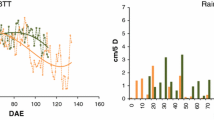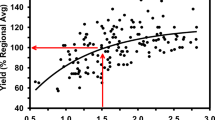Summary
The association of ground cover and ground cover duration with fresh- and dry-weight potato tuber yields in a semi-arid Mediterranean climate, was investigated. Cultivars of different maturity classes were tested under the contrasting climatological conditions of the spring and autumn seasons. The correlation coefficients of ground cover (GC) and ground cover duration (GCD) with fresh- and dry-weight tuber yields were lower for the autumn than for the spring season. In both seasons, high yields were positively correlated with high GCD. However, variation in tuber yields was evident in cultivars with similar GCD, indicating the involvement of factors other than ground cover and light interception in tuber yield.
Zusammenfassung
Es wurde der Zusammenhang zwischen der Bodenabdeckung (GC) durch das grüne Kraut und dem Frisch- und Trockengewicht der Knollenerträge im Frühjahr und Herbst unter Klimabedingungen untersucht, die in Abbildung 1 dargestellt sind.
Die Werte von GC und von der Dauer der Bodenabdeckung (GCD) für die Herbst- und Frühjahrsperioden sind in den Tabellen 1 bzw. 3 zusammengefasst.
Grössere Abweichungen bei GC und GCD zwischen den Sorten widerspiegeln auch deren Reifeklassen. Die Frisch- und Trockengewichte der Knollenerträge werden zusammen mit anderen Pflanzen- und Knolleneigenschaften in den Tabellen 2, 4 und 5 gezeigt.
Die Korrelationskoeffizienten von GC und GCD während der Wachstumszeit mit den Knollenerträgen sind für die Herbst- und Frühjahrsperioden in den Abbildungen 3 bzw. 5 dargestellt. Die Korrelationskoeffizienten von GC und GCD mit den frischen und den trockenen Knollenerträgen gegen Ende der Wachstumszeit waren im Herbst am niedrigsten (Abbildungen 2–5). In beiden Wachstumsperioden waren hohe Erträge positiv korreliert mit hohem GCD (Abbildungen 2 und 4), Schwankungen der Knollenerträge bei Sorten mit ähnlichem GCD (Abbildungen 2 und 4) weisen jedoch auf andere Faktoren hin, die neben GC und einem eingeschränkten Lichteinfall den Knollenertrag beeinflussen.
Résumé
La relation entre la couverture du sol (GC) par le feuillage et les rendements en matière fraiche et en matière sèche des tubercules a été étudiée au printemps et en automne dans les conditions climatiques mentionnées sur la figure 1. Les données pour GC et pour la durée de GC (GCD) au cours de ces deux saisons sont identiques, respectivement dans les tableaux 1 et 3. On observe une grande variation entre les variétés pour GC et GCD, ce qui reflète leur différence de maturation. Les rendements en poids frais et en poids sec sont montrés dans les tableaux 2, 4 et 5.
Les coefficients de corrélation de GC et de GCD avec les rendements en tubercules pendant la période de croissance sont présentés dans les figures 3 et 5 respectivement pour l'automne et le printemps.
Les coefficients de corrélation de GC et de GCD avec les teneurs en matière fraiche et en matière sèche des tubercules vers la fin de la période de croissance s'avéraient plus bas pour l'automne (figures 2, 5). Pour les deux saisons de hauts rendements étaient corrélés positivement avec une haute GCD (figures 2, 4) mais la variation de rendement en tubercules au sein des variétés pour une GCD identique (figures 2 et 4) indiquait que d'autres facteurs que GC et l'interception de la lumière affectent le rendement en tubercules.
Similar content being viewed by others
References
Allen, E. J. & R. K. Scott, 1980. An analysis of growth of the potato crop.Journal of Agricultural Science, Cambridge 94: 583–606.
Bean, J. N., 1984. Light interception and leaf growth.Potato Research 27: 313.
Bodlaender, K. B. A., 1963. Influence of temperature, radiation and photoperiod on development and yield. The growth of the potato. Proceedings of the 10th Easter School of Agricultural Science, University of Nottingham, p. 199–210.
Burstal, L. & P. M. Harris, 1983. The estimation of percentage light interception from leaf area index and percentage ground cover in potatoes.Journal of Agricultural Science, Cambridge 100: 241–244.
Emilson, B. 1949. Studies on the rest period and dormant period in the potato tuber.Acta Agriculturae Suecana 3: 189–284.
Ewing, E. E., 1981. Heat stress and tuberization stimulus.American Potato Journal 58: 31–49.
Krijthe, N., 1962. Observations on the sprouting of seed potatoes.European Potato Journal 5: 316–333.
Levy, D., 1978. Heat tolerance in potatoes and its effect on tuber yielding capacity in hot climates.Israel Journal of Botany 27: 35.
Levy, D., 1981. Effects of high ambient temperatures and water stress on the formation of misshapen tubers and on tuber sprouting before harvest. In: Abstracts of Conference papers of 8th Triennial Conference EAPR (München, 1981): 224–225.
Levy, D., 1984. CultivatedSolanum tuberosum L. as a source for the selection of cultivars adapted to hot climates.Tropical Agriculture (Trinidad) 61: 167–170.
Levy, D., 1986. Tuber yield and tuber quality of different potato cultivars as affected by seasonal high temperatures and by water deficit in a semi-arid environment.Potato Research 29: 95–107.
Marinus, J. & K. B. A. Bodlaender, 1975. Response of some potato varieties to temperature.Potato Research 18: 189–204.
Sale, P. J. M., 1973. Productivity of vegetable crops in a region of high solar input. I. Growth and development of the potato (Solanum tuberosum L.).Australian Journal of Agricultural Research 24: 733–749.
Slomnicki, I., 1960. Screening potato varieties for short day dormancy.European Potato Journal 4: 201–210.
Slomnicki, I., 1961. Potato growing two seasons a year from local seeds in Israel. In: Advances in Horticultural Science and their Applications. Proceedings International Horticultural Congress, Vol. I: 476–481.
Sorin, O. & D. Shimshi, 1984. Getting early tuber yield of autumn potatoes by early planting and storage of the seed tubers under conditions of varied temperatures.Hassadeh 54: 2216–2219 (in Hebrew).
Susnoschi, M., 1981a. Seed potato quality as influenced by high temperatures during the growth period. 1. Effect of storage temperature on sprout growth.Potato Research 24: 371–379.
Susnoschi, M., 1981b. Seed potato quality as influenced by high temperatures during the growth period. 2. Sprouting pattern in several cultivars in response to storage temperature.Potato Research 24: 381–388.
Author information
Authors and Affiliations
Additional information
Contribution from the Agricultural Research Organization, The Volcani Center, Bet Dagan, Israel, No 1557-E, 1985 series.
This investigation was supported by a grant from the Ministry of Foreign Affairs, Technical Assistance Department, Netherlands.
Rights and permissions
About this article
Cite this article
Levy, D., Livesku, L. & Van Der Zaag, D.E. Double cropping of potatoes in a semi-arid environment: the association of ground cover with tuber yields. Potato Res 29, 437–449 (1986). https://doi.org/10.1007/BF02357909
Accepted:
Issue Date:
DOI: https://doi.org/10.1007/BF02357909




